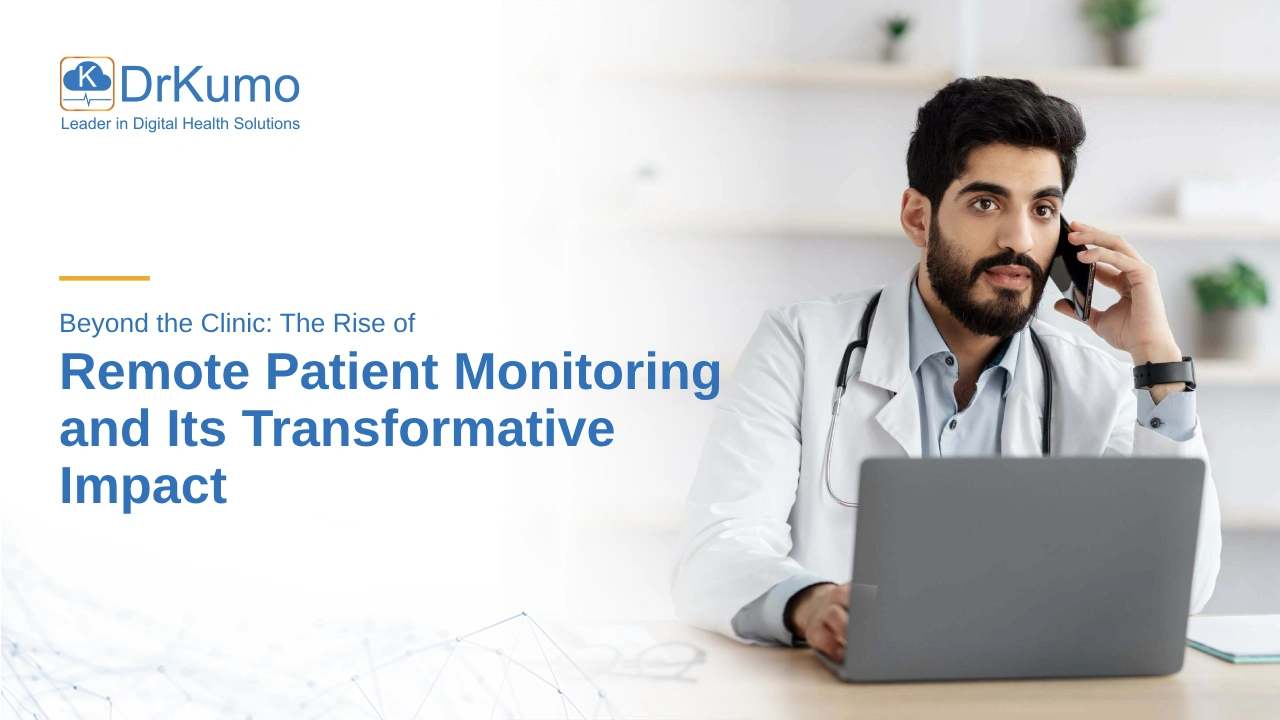Remote Patient Monitoring (RPM) is rapidly transforming the healthcare landscape, allowing patients to receive medical care and monitoring without needing to visit a healthcare facility physically. RPM collects health data in real-time and transmits it to healthcare providers, enabling timely analysis and intervention. The effectiveness of this approach depends on various factors, including patient engagement and the responsiveness of the healthcare team.
Patient monitoring is not entirely new; its origins date back to early telehealth initiatives where doctors would consult with patients over the phone or via video calls. However, technological advancements such as wearable devices, artificial intelligence (AI), and secure data transmission have accelerated the adoption of RPM. The rise of chronic diseases, increasing healthcare costs, and a growing aging population have also driven the demand for more effective, remote-based care.
Why Remote Patient Monitoring Is Gaining Popularity
Remote patient monitoring (RPM) is becoming a vital component of modern healthcare due to several key factors. DrKumo’s RPM solutions, for example, utilize AI-driven analytics and real-time data to help healthcare teams make informed decisions, contributing to the reduction of healthcare costs and improving care accessibility:
- Rising healthcare costs – Traditional in-person care is expensive, and RPM offers a more cost-effective alternative. Studies have shown that RPM can significantly reduce healthcare expenses. For instance, a study demonstrated that direct costs decreased from $25,000 to $12,000 (p < 0.001), and indirect costs decreased from less than $10,000 to less than $5,000 (p = 0.004) with the implementation of RPM.
- Aging population – More elderly patients require regular monitoring, making RPM a practical solution for continuous care for them but RPM can also help younger individuals with chronic conditions who require continuous monitoring and adjustments to their care. RPM enables healthcare providers to monitor patients’ health in real-time and intervene proactively.
- Technological innovations – The rise of wearables, mobile health apps, and AI-powered data analysis has made RPM more efficient and accessible. These technological advancements enhance the ability to monitor patients remotely and provide timely interventions.
The benefits of remote patient monitoring extend to both patients and healthcare providers. It bridges the gap between patients and healthcare providers, ensuring that even those in remote or underserved areas can access quality care.
Latest Trends on Remote Patient Monitoring
RPM is not just a passing trend but a significant shift in delivering healthcare. Here’s a more detailed breakdown of the latest trends and statistics:
Evolution of Technology
The sophistication of wearable devices is rapidly increasing. We’re seeing devices that can monitor more than just basic vitals, including detailed ECGs, sleep patterns, and even subtle changes in gait that might indicate neurological issues.
AI and machine learning are moving beyond simple data analysis to predictive modeling. This means RPM systems can anticipate potential health crises before they occur, allowing for proactive interventions. Integrating RPM with Electronic Health Records (EHRs) is becoming more seamless, providing healthcare providers with a comprehensive view of patient health.
“Hospital-at-Home” models are rapidly gaining traction as an alternative to traditional hospital care. These models allow patients to receive acute-level care in the comfort of their own homes, reducing the burden on hospitals and improving patient satisfaction. This is enabled by sophisticated RPM devices and platforms allowing continuous monitoring of vital signs and other health metrics.
Emphasis on Personalized Care
RPM is enabling a shift towards more personalized healthcare. By continuously collecting patient data, RPM can help healthcare providers adjust treatment plans more precisely to meet individual patient needs, particularly for those with chronic conditions, who often require ongoing monitoring and adjustments to their treatment.
By integrating data from RPM devices with electronic health records, clinicians gain a deeper understanding of each patient’s medical history and real-time health trends. This allows for predictive analytics that can anticipate potential complications before they arise, leading to proactive rather than reactive care.
Additionally, personalized care via RPM promotes greater patient engagement. When individuals see how their daily behaviors and choices impact their health metrics in real time, they are more likely to adhere to treatment regimens and make informed lifestyle changes. This level of customization leads to better outcomes and improved patient satisfaction.
Increased Focus on Mental Health
RPM is increasingly being used to monitor mental health conditions. RPM offers valuable insights into mental health by monitoring sleep patterns, activity levels, and mood, complementing traditional mental health care and supportive proactive interventions. The combination of physiological data and observed behavioral data gives clinicians a complete picture of patient health.
These tools can also facilitate earlier interventions by identifying warning signs of anxiety, depression, or other mental health disorders before they escalate. For example, a sudden decrease in physical activity combined with poor sleep quality can signal a depressive episode, prompting timely outreach from healthcare providers.
Moreover, RPM enhances access to mental health support for underserved or remote populations. Virtual mental health monitoring breaks down geographical and logistical barriers, enabling individuals to receive consistent support regardless of location. This is especially crucial during times of crisis or for patients reluctant to seek in-person care.
Regulatory and Reimbursement Changes
Governments and insurance providers are increasingly recognizing the value of RPM, leading to changes in regulations and reimbursement policies. This is making RPM more accessible to patients and encouraging healthcare providers to adopt these technologies. As regulatory and reimbursement policies evolve, DrKumo’s RPM solutions ensure compliance with the latest standards, making it easier for healthcare providers to adopt and benefit from remote monitoring.
New reimbursement models are being developed to account for virtual care delivery, including codes that cover remote monitoring of vitals, medication adherence, and virtual consultations. These changes not only validate the importance of RPM in modern healthcare but also incentivize innovation and investment in digital health infrastructure.
Regulatory bodies are also focusing on creating clearer guidelines for RPM device certification and data handling protocols. These evolving standards are helping to build trust among patients and providers, ensuring that RPM technologies are both safe and effective in real-world clinical use.
Cybersecurity
With the increase in patient information being transferred, cybersecurity is becoming a larger part of every RPM platform, with the need to maintain HIPAA compliance and other data security standards.
As RPM systems become more interconnected, they are more vulnerable to cyber threats such as data breaches, ransomware, and unauthorized access. To counter these risks, developers are investing heavily in end-to-end encryption, secure APIs, and multi-factor authentication mechanisms to safeguard sensitive health information.
Cybersecurity is also critical in maintaining user trust. Patients are more likely to embrace RPM technologies when they are confident their personal data is protected. Regular audits, compliance with evolving standards like GDPR and HIPAA, and transparent privacy policies are essential components of a robust cybersecurity framework in the RPM ecosystem. DrKumo’s platform adheres to the highest cybersecurity standards, ensuring that patient data is transmitted securely and remains HIPAA-compliant, protecting both patient privacy and healthcare provider integrity.
Its Statistics and Impact on Healthcare
Market Growth Projections
RPM’s potential for growth is significant, with some projections indicating a compound annual growth rate (CAGR) of over 20%. While RPM has shown promise in reducing healthcare costs and hospital readmissions, outcomes may vary based on factors such as patient engagement, condition severity, and healthcare provider adoption.
Patient and Provider Adoption
Surveys indicate that many patients and healthcare providers are embracing RPM technologies. Accordingly, RPM reduces the time nurses dedicate to routine monitoring, communication, and coordination, freeing up 43.11% more time for direct patient care. Patient satisfaction rates with RPM are high, with many patients reporting that it improves their quality of life and a sense of control over their health. Many physicians are now utilizing RPM technologies, especially those specializing in chronic disease management.
Impact on Healthcare Costs
Studies have shown that RPM can significantly reduce healthcare costs, particularly by reducing hospital readmissions and emergency room visits. A survey of 25 healthcare organizations with RPM programs found that 38% reported reduced admissions and 17% cited cost reductions. RPM can also help improve medication adherence, which can prevent costly complications.
Wearable Device Market
The wearable device market is booming, with millions of devices sold yearly. With a 6.1% year-over-year increase, global shipments of hearables, watches, wristbands, and other wearables were forecast to hit approximately 543 million units in 2024. The increasing availability of affordable and accurate wearable devices drives this growth. By understanding these trends and statistics, healthcare providers and patients can make informed decisions about using RPM technologies.
Patient Monitoring and Chronic Disease Management
RPM is particularly effective for managing chronic conditions. DrKumo’s RPM platform offers tailored solutions for managing conditions such as diabetes, hypertension, and COPD, leveraging real-time data and AI-powered analytics to ensure timely interventions.
- Diabetes – Continuous glucose monitoring helps prevent complications.
- Hypertension – Regular blood pressure monitoring ensures timely intervention.
- Heart Disease – RPM devices monitor heart rhythms and detect arrhythmias.
- Chronic Obstructive Pulmonary Disease (COPD) – Monitoring oxygen levels and lung function helps prevent exacerbations.
RPM programs enable healthcare providers to access real-time data, supporting the development of personalized care plans for patients with chronic conditions. The extent to which care plans can be adjusted depends on the capabilities of the healthcare system.
Impact of RPM on Healthcare Providers
Healthcare providers benefit significantly from RPM:
- Improved Workflow – Providers can monitor multiple patients simultaneously, improving efficiency.
- Data-Driven Decision Making – Real-time data enables more accurate and timely clinical decisions.
- Reduced Burnout – Automated monitoring minimizes the workload for healthcare professionals.
Healthcare organizations adopting RPM see improved patient outcomes and operational efficiency. While RPM can help improve workflow and reduce burnout by automating routine monitoring, its full potential depends on healthcare providers’ ability to integrate the technology effectively into existing practices.
Takeaways
RPM rapidly reshapes healthcare by providing accessible and efficient care beyond traditional clinical settings. Using real-time data collection and analysis, RPM has the potential to enhance proactive health management, improve outcomes, and reduce healthcare costs, particularly when integrated into comprehensive care plans and supported by healthcare teams. This approach benefits individuals with chronic conditions, allowing for timely interventions and better health management.
The effectiveness of RPM stems from its ability to enhance patient engagement and empower individuals to participate actively in their care. By leveraging wearable devices and advanced technologies, patients receive real-time feedback and maintain consistent communication with healthcare providers. This data-driven approach facilitates informed decision-making and personalized care plans, ultimately improving patient satisfaction and adherence to treatment.”
To fully capitalize on RPM’s transformative impact, consider DrKumo Digital Health Solutions. DrKumo’s comprehensive platform offers advanced remote monitoring devices, AI-powered data analytics, and seamless communication tools, enabling the delivery and receipt of quality care from any location.
Discover how DrKumo can revolutionize your healthcare delivery. Contact us today!
Disclaimer: This article provides general information about Remote Patient Monitoring (RPM) and its potential impact. It is not intended as medical advice. Consult with a qualified healthcare professional for personalized guidance regarding your health and treatment options. The information presented here should not be used as a substitute for professional medical advice.








